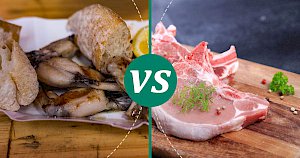Pork vs Frog Legs: Nutrition & Calories Compare


Pork vs Frog legs
Nutrition Facts
Serving size:
change
5g10g15g20g30g40g50g60g80g100g120g140g160g180g200g220g250g300g350g400g450g500g600g700g800g900g1000g
1oz2oz3oz4oz5oz6oz7oz8oz10oz12oz15oz20oz25oz30oz35oz40oz50oz
Amount Per Serving:
Serving size:
change
5g10g15g20g30g40g50g60g80g100g120g140g160g180g200g220g250g300g350g400g450g500g600g700g800g900g1000g
1oz2oz3oz4oz5oz6oz7oz8oz10oz12oz15oz20oz25oz30oz35oz40oz50oz
Amount Per Serving:
Pork vs Frog Legs 100g Compare
| per 100g | Pork | Frog legs |
|---|---|---|
| Calories | 242 | 73 |
| Fat | 13.92 g | 0.3 g |
| Protein | 27.32 g | 16.4 g |
| Water | 57.87 g | 81.9 g |
| Calcium | 19 mg | 18 mg |
| Iron | 0.87 mg | 1.5 mg |
| Magnessium | 28 mg | 20 mg |
| Phosphorus | 1.3 mg | 0.1 mg |
| Potassium | 423 mg | 285 mg |
| Sodium | 62 mg | 58 mg |
| Zink | 1.3 mg | 0.1 mg |
| Vitaminium A | 7 µg | 50 µg |
| Vitaminium B1 (Thiamine) | 0.877 mg | 0.14 mg |
| Vitaminium B2 (riboflavin) | 0.321 mg | 0.25 mg |
| Vitaminium B3 (Niacin) | 5.037 mg | 1.2 mg |
| Vitaminium B6 | 0.464 mg | 0.12 mg |
| Vitaminium B9 (Folic acid) | 0.005 mg | 0.015 mg |
| Vitaminium E | 0.29 mg | 1 mg |
Exploring the Culinary Delights: Pork vs. Frog Legs
When it comes to exploring diverse cuisines from around the globe, pork and frog legs stand out as two intriguing options. Each offers a unique taste, texture, and culinary history that can add an exotic touch to your dining experience. But beyond their delicious flavors, how do pork and frog legs compare in terms of nutrition, health benefits, and culinary versatility? Let’s dive into the fascinating world of these two distinct ingredients and discover what sets them apart.
A Journey Through Flavor and Tradition
Pork, known as the culinary name for meat derived from domestic pigs, has been a staple in various cultures worldwide for centuries. Its rich, savory flavor and versatility make it a favorite in dishes ranging from slow-cooked roasts to spicy sausages. On the other hand, frog legs, often associated with French and Asian cuisines, are praised for their delicate flavor and texture, reminiscent of chicken but with a unique twist. These amphibian limbs are considered a delicacy in many parts of the world, offering a culinary adventure for those looking to expand their palate.
Nutritional Face-Off
When comparing the nutritional profiles of pork and frog legs, it's clear that both offer valuable nutrients, but with significant differences in caloric and fat content. Pork is richer in calories, with 242 calories per serving, and contains a higher fat content, at 13.92 grams, making it a more indulgent choice. Frog legs, on the other hand, are much leaner, with only 73 calories and 0.3 grams of fat per serving, presenting a lighter alternative.
Protein-wise, pork provides a robust 27.32 grams per serving, making it a great source of this essential macronutrient. Frog legs are not far behind, with 16.4 grams of protein, coupled with their high water content of 81.9%, which contributes to their low-calorie count. Both meats are low in carbohydrates and sugars, making them suitable for low-carb diets.
In terms of vitamins and minerals, both pork and frog legs have their merits. Pork is a good source of vitamins B1, B3, and B6, essential for energy metabolism and cognitive health. Frog legs excel in vitamin A and vitamin E, which are crucial for vision and skin health, respectively. They also offer more iron and less cholesterol than pork, making them a heart-friendly option.
Culinary Flexibility and Flavor
The culinary applications of pork and frog legs are as diverse as their nutritional profiles. Pork's rich flavor and fat content make it suitable for a wide range of cooking methods, including roasting, grilling, and slow-cooking, allowing it to absorb a variety of flavors and seasonings. Its versatility extends from savory breakfast sausages to elegant dinner roasts.
Frog legs, with their delicate flavor, pair well with light seasonings and cooking methods that highlight their natural taste, such as sautéing or grilling. They are often marinated in garlic, herbs, and butter to enhance their subtle flavor, making them a sophisticated addition to any meal.
Conclusion: A Place for Both on the Table
Whether you prefer the hearty richness of pork or the delicate, lean quality of frog legs, both offer unique flavors and nutritional benefits that can complement a balanced diet. While pork provides a satisfying, protein-packed option for meat lovers, frog legs offer a lighter, equally nutritious alternative for those seeking something out of the ordinary. By exploring the culinary and nutritional aspects of these two fascinating foods, you can enrich your diet with a wider variety of tastes and textures. So why not indulge your adventurous side and give both a place at your table?
Pork 100g
242kcalCalories source
- 0% CARBS.
- 47% PROTEIN
- 53% FAT
Frog legs 100g
73kcalCalories source
- 0% CARBS
- 96% PROTEIN
- 4% FAT
Compares of pork
- Pork vs Chicken Breast
- Pork vs Duck Meat
- Pork vs Luncheon Meat
- Pork vs Veal
- Pork vs Rabbit
- Pork vs Beef Jerky
- see all compares of pork
Marcin Piotrowicz
calories-info.com creator
Healthy diet and healthy lifestyle promoter
Add comment